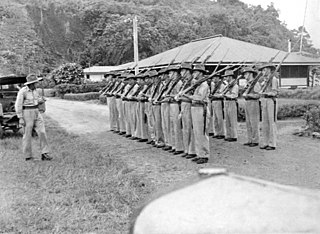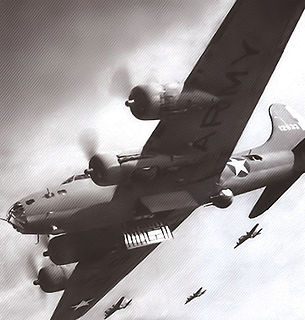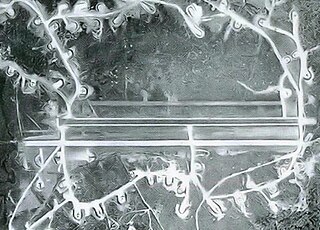
The Battle of the Bismarck Sea took place in the South West Pacific Area (SWPA) during World War II when aircraft of the U.S. Fifth Air Force and the Royal Australian Air Force (RAAF) attacked a Japanese convoy carrying troops to Lae, New Guinea. Most of the Japanese task force was destroyed, and Japanese troop losses were heavy.

Operation Chronicle was the Allied invasion of Woodlark and Kiriwina Islands, in the South West Pacific, during World War II. The operation was a subordinate action that formed part of the wider Operation Cartwheel, the advance towards Rabaul. An early planning name for this operation was Operation Coronet. Preliminary actions commenced on 23–24 June 1943 when small reconnaissance parties were landed on both islands. The main operation was executed without opposition on 30 June 1943. Around 16,800 personnel took part, divided into two forces. The United States Army provided the majority of ground troops, which were supported by a United States Marine Corps defense battalion as well as U.S. and Australian aircraft and naval vessels.

The New Guinea campaign of the Pacific War lasted from January 1942 until the end of the war in August 1945. During the initial phase in early 1942, the Empire of Japan invaded the Australian-administered Mandated Territory of New Guinea and the Australian Territory of Papua and overran western New Guinea, which was a part of the Netherlands East Indies. During the second phase, lasting from late 1942 until the Japanese surrender, the Allies—consisting primarily of Australian forces—cleared the Japanese first from Papua, then the Mandate and finally from the Dutch colony.

Camden Airport is an aerodrome located on the outskirts of Sydney 1 nautical mile northwest of Camden, New South Wales, Australia. The airport is located approximately 60 km (37 mi) from Sydney's central business district. Camden is used as a general aviation overflow airport for the busier Bankstown Airport; and provides facilities for gliding and ballooning. The aerodrome has one grass- and one paved runway and two glider airstrips. It is in the south-west corner of the designated Sydney flight training area.

Madang Airport, is an airport located in Madang, Papua New Guinea.

Lae Nadzab Airport is a regional airport located at Nadzab 42 kilometres (26 mi) outside Lae, Morobe Province, Papua New Guinea along the Highlands Highway. It is served by both private and regional aircraft with domestic flights. The airport replaced the Lae Airfield in 1977.

The Battle of Wau, 29 January – 4 February 1943, was a battle in the New Guinea campaign of World War II. Forces of the Empire of Japan sailed from Rabaul and crossed the Solomon Sea and, despite Allied air attacks, successfully reached Lae, where they disembarked. Japanese troops then advanced overland on Wau, an Australian base that potentially threatened the Japanese positions at Salamaua and Lae. A race developed between the Japanese moving overland, hampered by the terrain, and the Australians, moving by air, hampered by the weather. By the time the Japanese reached the Wau area after a trek over the mountains, the Australian defenders had been greatly reinforced by air. In the battle that followed, despite achieving tactical surprise by approaching from an unexpected direction, the Japanese attackers were unable to capture Wau.

The Salamaua–Lae campaign was a series of actions in the New Guinea campaign of World War II. Australian and United States forces sought to capture two major Japanese bases, one in the town of Lae, and another one at Salamaua. The campaign to take the Salamaua and Lae area began after the successful defence of Wau in late January, which was followed up by an Australian advance towards Mubo as the Japanese troops that had attacked Wau withdrew to positions around Mubo. A series of actions followed over the course of several months as the Australian 3rd Division advanced north-east towards Salamaua. After an amphibious landing at Nassau Bay, the Australians were reinforced by a US regimental combat team, which subsequently advanced north up the coast.

The New Guinea Volunteer Rifles (NGVR) was an infantry battalion of the Australian Army. It was initially raised as a unit of the Militia from white Australian and European expatriates in New Guinea upon the outbreak of the Second World War in 1939, before being activated for full-time service following the Japanese landings in early 1942. NGVR personnel then helped rescue survivors of Lark Force from Rabaul in February and March 1942. Between March and May, the NGVR monitored the Japanese bases which had been established in the Huon Gulf region, being the only Allied force in the area until the arrival of Kanga Force at Wau in May. The battalion subsequently established observation posts overlooking the main approaches and reported on Japanese movements.

The Battle of Kaiapit was an action fought in 1943 between Australian and Japanese forces in New Guinea during the Markham and Ramu Valley – Finisterre Range campaign of World War II. Following the landings at Nadzab and at Lae, the Allies attempted to exploit their success with an advance into the upper Markham Valley, starting with Kaiapit. The Japanese intended to use Kaiapit to threaten the Allied position at Nadzab, and to create a diversion to allow the Japanese garrison at Lae time to escape.
Vivigani Airfield was an airstrip at Vivigani on Goodenough Island, part of the D'Entrecasteaux Islands in Papua New Guinea.

Eagle Farm Airport was a small airport located 6 km (3.7 mi) north-east of Brisbane in the suburb of Eagle Farm, Queensland, Australia.

The 2/6th Commando Squadron was one of 12 independent companies or commando squadrons raised by the Australian Army during the Second World War. Raised in May 1942 as the 2/6th Independent Company, the 2/6th's main role was to conduct irregular type warfare including small scale raiding, sabotage, long-range patrolling and reconnaissance operations rather than the traditional commando type direct action operations. As such, for the most part the unit conducted operations in small groups operating inside enemy territory, or out in front of larger friendly forces. Between 1942 and 1945, the 2/6th undertook four major campaigns during the war—Kokoda, Buna, Markham–Ramu and Borneo—and was involved in arguably one of the most spectacular small unit actions of the war during the Battle of Kaiapit. The unit was disbanded in January 1946, following the cessation of hostilities in the Pacific.

New Guinea Force was a military command unit for Australian, United States and native troops from the Territories of Papua and New Guinea serving in the New Guinea campaign during World War II. Formed in April 1942, when the Australian First Army was formed from the Australian I Corps after it returned from the Middle East, it was responsible for planning and directing all operations within the territory up until October 1944. General Headquarters Southwest Pacific Area Operational Instruction No.7 of 25 May 1942, issued by Commander-Allied-Forces, General Douglas MacArthur, placed all Australian and US Army, Air Force and Navy Forces in the Port Moresby Area under the control of New Guinea Force. Over the course of its existence, New Guinea Force was commanded by some of the Australian Army's most notable commanders, including Sydney Rowell, Sir Edmund Herring and Sir Leslie Morshead.

The Landing at Nadzab was an airborne landing on 5 September 1943 during the New Guinea campaign of World War II in conjunction with the landing at Lae. The Nadzab action began with a parachute drop at Lae Nadzab Airport, combined with an overland force.

Lae Airfield is a former World War II airfield and later, civilian airport located at Lae, Morobe Province, Papua New Guinea. The airport was closed in the 1980s, in favour of Lae Nadzab Airport, which was able to accommodate larger jet aircraft. The airport was known as Lae Drome or Lae Aerodrome

The invasion of Salamaua–Lae, called Operation SR by the Japanese, was an operation by Imperial Japanese forces to occupy the Salamaua–Lae area in the Territory of New Guinea during the Pacific campaign of World War II. The Japanese invaded and occupied the location in order to construct an airfield and establish a base to cover and support the advance of Japanese forces into the eastern New Guinea and Coral Sea areas. The small Australian garrison in the area withdrew as the Japanese landed and did not contest the invasion.

The Port Moresby Airfield Complex was a World War II military airfield complex, built near Port Moresby in the Territory of Papua and New Guinea. It was used during the Battle of New Guinea as a base of Allied air operations primarily in 1942 and early 1943. It later became a support base as the battle moved to the north and western part of New Guinea. It was closed and the facility turned over to civil authorities after the end of the war in September 1945.

Vannes Airport is a regional airport in France. It supports general aviation.

The Battle of Mubo was a series of actions in the Mubo area of the Territory of New Guinea between Australian and Japanese forces which took place between 22 April and 14 July 1943, during World War II. The battle formed part of the wider Salamaua–Lae campaign, and was fought in the early stages of the campaign. The battle followed the successful defence of the airfield around Wau by the Australians in late January 1943, after the Japanese had attempted to infiltrate the Australian positions with two infantry battalions.



















